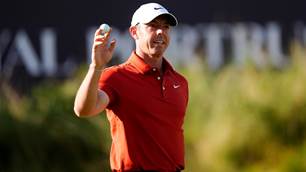Golf’s oldest major championship, The Open, returns to the Kingdom of Fife and the spiritual home of the game, St. Andrews – far removed from its humble beginnings 162 years ago.
The first ball in Open Championship history was struck on October 17, 1860, at Prestwick Golf Club on Scotland’s Ayrshire Coast. The tournament, with eight starters, was played over three rounds of the 12-hole course with Willie Park Snr defeating Old Tom Morris by two strokes. He was proclaimed the Champion Golfer of the Year – a tradition that continues today – and received the Challenge Belt and no prizemoney.
When Old Tom turned the tables a year later, defeating his arch-rival by four strokes, he received the belt but none of the £10 prizemoney, which was split between the second, third and fourth placegetters.
Both Park and Old Tom would win four Open championships each, while Old Tom’s son, Young Tom Morris won three consecutive championships from 1868, which, under the rules of the tournament, entitled him to keep the Challenge Belt.
Without a belt or other trophy to play for, the Open was not played in 1871. When the tournament returned in 1872, Young Tom – at the age of just 21 – was the winner again and was presented with the Auld Claret Jug. Sadly, the young phenom died just three years later.

Young Tom’s name is the first engraved on the trophy that will be hoisted by this year’s Champion Golfer of the Year, who will also receive a winner’s cheque of US$2.5 million.
DEFENDING CHAMPION: American Collin Morikawa handed the Claret Jug back to the R&A on Monday and received a replica to keep in its return. He begins his title defence searching for the form that saw him leave Royal St. Georges the No.3 ranked played in the world.
Now ranked World No.8, the 25-year-old has won only once – the DP World Tour Championship – since hoisting the coveted Open trophy a year ago.
“I am looking for something,” Morikawa said. “We're at the end of our season. We're at the fourth major. Playoffs are coming up pretty soon. I want to give it a run. I really haven't been in contention at all this year in any tournament, and it sucks because I love being in those spots.
“I love coming down the stretch and knowing that you've got to make some great shots, make some birdies, and close it out, and I just haven't put myself in that position.”

As the reigning Open Champion there are distractions from the job at hand this week, but with St. Andrews sightseeing and media interviews done and dusted, he’s ready to go.
“I did that (sightseeing) all on Sunday when I got here, and I'm over it. I have to,” he said. “That's the only way I can focus on this tournament. You've got to embrace the history. You have to embrace everything. Everything that has happened before us.
“But I'm here to win a tournament.
“I'm here to play some really good golf. Even though my week is filled with the couple extra media obligations and a couple other appearances doesn't mean by Thursday morning I'll not be ready.
“I'm going to do everything I can, just like any other event I've played well in or won, to be waking up Thursday morning ready to play 72 holes of really good golf.”
COURSE: There is no better place for the 150th staging of the Open Championship than the spiritual home of the game, St. Andrews. Golf was first played across the rolling links beside West Sands Beach in the early 15th century before James II of Scotland banned the game in 1457 before he believed golf was interfering with the archery practice of St. Andrews’ young men. The ban stayed in place for nearly 50 years until James IV fell in love with the game.
The Old Course – which was first named the Old, with the opening of the adjoining New Course in 1895 – existed for hundreds of years with no major design input. It wasn’t until 1764 that it was decided to reduce the number of holes from 22 to 18, which has become the course standard worldwide.
In 1863, Old Tom Morris – the keeper of the green at St. Andrews – separated the 1st green from the 17th to produce seven double greens and four single greens. It was around this time that the course began to see play in an anti-clockwise direction, which is how the layout is played today.

The Old Course has hosted the Open 30 times since 1873, which is more than any other course on the Open rota.
The course has been lengthened by just 16 yards to 7,313 yards (6,686 metres) for this year’s championship, with 13 of those yards devoted to a new tee on the par-3 8th, which will now play to 187 yards (170 metres) at its longest.
Across the journey, there remains 112 bunkers to avoid (the last Old Course bunker to be filled in was in 1949), some deep rough and hard, fast-running fairways already baked out by un-Scottish-like hot weather during the past week.
PRIZEMONEY: US$14,000,000
PLAYERS TO WATCH: This championship, I expect, will be one for the links specialists.
With no rain forecast over the course of the championship, the already browned-off and hard fairways plays right into the hands of those players, who control their ball the best and will cope with the inevitable bad bounces that are likely to get others hot under the collar.
The firm and dry conditions are similar to what the players faced at Carnoustie in 2018, which, for mine, eliminates a host of players who will not be able to overcome the temptation to attack the course. Brooks Koepka, for example, took two days to realise bombing drivers and gouging wedges out of the hay was not going to win him the championship. Bryson DeChambeau adopted a similar flawed strategy last year at Royal St. Georges with limited success.
RELATED: SO-CALLED EXPERTS OPEN CHAMPIONSHIP TIPS
You can also discount a host of American-based PGA Tour players, whose golfing life has consisted of a diet of soft fairways, soft greens and hitting to an exact distance and expecting their ball to stop at that distance. Learning to land the ball some 30-40 yards short of your ultimate target and knowing how the ball will bounce is a lesson not learned in 36, 45, or 54 holes of practice.

One American who does get links golf is Jordan Spieth. He proved that in his first Open appearance at St. Andrews in 2015 when he finished T4 and just one shot out of the playoff, eventually won by Zach Johnson.
He was right in contention through 63 holes of the Scottish Open last week and the 2017 Open Champion, who also finished Top-10 at Carnoustie, will enjoy the way the Old Course is going to play this week. The harder the conditions get, the better he will score.
The conditions certainly suit Tiger Woods, who over the past few days has spent more time than most hitting short game shots with a range of clubs. As the winner of two Open titles at St. Andrews no player knows the nuances of the Old Course better than the 15-time major winner.
In practice – with exception of his first half dozen holes on Monday – he has been striking the ball well. But it from what I have seen of his short game work, he is a genuine contender if the wind plays its part in the result. For example, Woods hit four shots from about 30 yards short of the 2nd green in practice, using different clubs for each and each ball finished within a two-metre radius of the flag. It was vintage stuff.

The Old Course routing – with all the really significant trouble, like out-of-bounds, located to the right of most holes – will favour players with a left-to-right stock shot shape (even more so with the wind direction predicted over the first few days of the championship). This brings World No.1 Scottie Scheffler into serious consideration, but his performance relies totally on getting out of his comfort zone and embracing links golf before he tes off on Thursday.
Two more faders, who won’t mind the conditions, are good mates Cameron Smith and Marc Leishman.
Of course, Leishman, after just making the cut, fired weekend rounds of 64-66 to make the playoff here in 2015. His ability to not get fazed by bad bounces and remain patient are his strengths beyond his obvious ball-striking talent will serve him well again this week.

Likewise, nothing seems to rattle Smith. On a fiery Old Course, there will be plenty of club slamming and a few profanities over the journey for most of the field, but not from Smith. He always considers himself in the fight and when others are heads down, he’s heads up and ready to go. It also helps to have one of the best short games on the planet.
72-HOLE OPEN CHAMPIONSHIP RECORD: 264 (20 under), Henrik Stenson
18-HOLE OPEN RECORD AT THE OLD COURSE, ST. ANDREWS: 63 – Paul Broadhurst (3rd round 1990), Rory McIlroy (1st round, 2010).
PAST AUSSIE WINNERS: Peter Thomson (1954, 1955, 1956, 1958, 1965), Kel Nagle (1960), Greg Norman (1986, 1993), Ian Baker-Finch (1991).
AUSTRALIANS IN THE FIELD: Matthew Griffin, Lucas Herbert, Brad Kennedy, Min Woo Lee, Marc Leishman, Jed Morgan, Dimi Papadatos, Anthony Quayle, Adam Scott, Jason Scrivener, Cameron Smith.
TV TIMES*
FoxSports has a dedicated 150th Open Championship pop-up channel this week (505).
Live coverage of each round is below.
Round 1: Thursday (Fox Sports 505 3.30pm – 5am)
Round 2: Friday (Fox Sports 505 3.30pm – 5am)
Round 3: Saturday (Fox Sports 505 7pm – 5am)
Round 4: Sunday (Fox Sports 505 6pm – 4am)
*AEST, check local guides
Related Articles

The Aussies at The Open

McIlroy's Open inspiration: British Lions, Oppenheimer













